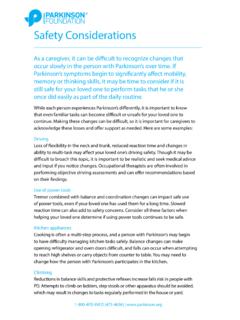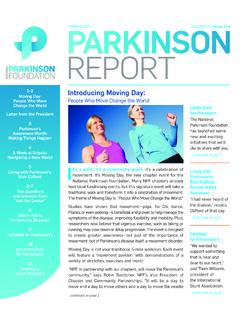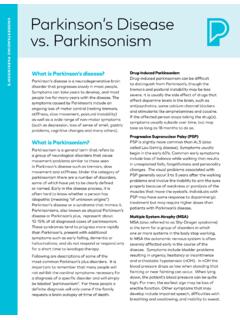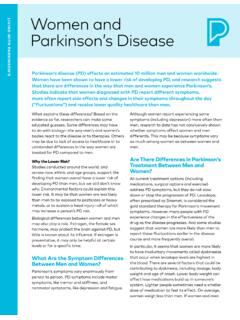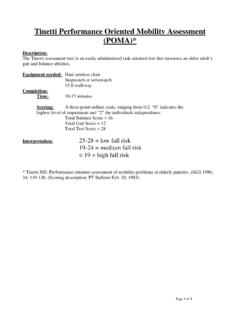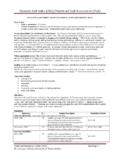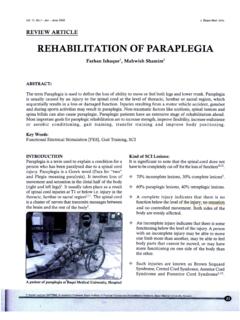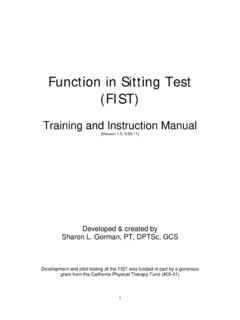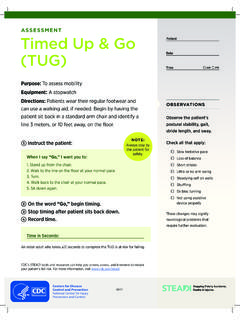Transcription of Deep Brain Stimulation - Parkinson's Foundation
1 Parkinson's Disease Deep Brain Stimulation A Practical Guide for Patients and Families By Michael S. Okun, MD, and Pamela R. Zeilman, MSN, ANP-BC. Deep Brain Stimulation : Practical Guide for Patients and Families 2. Deep Brain Stimulation : Practical Guide for Patients and Families Table of Contents Chapter 1 Introduction to Surgical Therapies for Parkinson's Chapter 2 An Overview of Deep Brain Stimulation (DBS) Chapter 3 Risks and Complications of DBS ..19. Chapter 4 Is DBS Right for You? ..23. Chapter 5 Preparing for Surgery ..25. Chapter 6 The Surgery.
2 29. Chapter 7 After Surgery Chapter 8 Adjustment of Chapter 9 Special Information and Warnings ..43. Chapter 10 Emerging Changes and Future Directions in DBS ..48. Appendix A Glossary of terms ..51. Appendix B Resource list ..54. About the Authors ..56. 3. Deep Brain Stimulation : Practical Guide for Patients and Families Chapter 1. Introduction to Surgical Therapies for Parkinson's Disease Parkinson's disease (PD) affects an estimated one million Americans including men and women of all ages and races, though it is slightly more common in men. Parkinson's is caused by a combination of genetic and environmental factors, with age being the main risk factor.
3 There is no cure, but there are many excellent symptomatic treatments. Medications, exercise, nutrition, holistic approaches, and surgical treatment all have the potential to reduce symptoms and to improve quality of life. Common symptoms of PD include shaking (tremor), slowness of movement (bradykinesia), muscle stiffness (rigidity), and difficulty with balance (postural instability). These are referred to as the motor symptoms of PD. There are also many non-motor symptoms, including most prominently depression, anxiety, apathy, fatigue, and sexual dysfunction.
4 During the initial stages of PD ( , the first several years after a diagnosis), medications typically control symptoms in the majority of patients. As the disease progresses, however, individuals may need to take more medications, increase the dosages, and, in many cases, take their medications more frequently. As disease duration increases, people with PD may notice that throughout a typical day they will experience periods of adequate symptom control ( on time ), periods where symptoms are much more noticeable ( off time ), and periods where peak medication levels (usually an hour after taking a medication dose) produce involuntary movements.
5 These involuntary movements are referred to as dyskinesia. When individuals change from one of these three states to another, they are said to have motor fluctuations. The aim of this book is to describe a type of surgical treatment that can be utilized to reduce PD symptoms in a subset of carefully selected individuals with a specific symptom or symptoms potentially responsive to this type of therapy. The treatment is known as deep Brain Stimulation (DBS). DBS is a proven and effective surgery that can be applied to treat some, but not all, of the disabling symptoms of PD.
6 There are several other surgeries that have been utilized to treat the symptoms of PD, and these include thalamotomy, pallidotomy, and subthalamotomy. We will discuss each of these alternative techniques, all of which rely on making a lesion in the Brain , in the pages that follow. When applied with the appropriate level of expertise, these therapies may also be options for individuals with PD. 4. Deep Brain Stimulation : Practical Guide for Patients and Families Pallidotomy, thalamotomy, and subthalamotomy Pallidotomy, thalamotomy, and subthalamotomy are types of surgical procedures in which a tiny heated probe is inserted into a precise region of the Brain to destroy tissue.
7 When the region known as the globus pallidus internus is lesioned, we refer to the procedure as a pallidotomy. Similarly, when the part of the Brain called the thalamus is treated, we call it a thalamotomy. And when the subthalamic nucleus is lesioned, we refer to the procedure as a subthalamotomy. Of these three procedures, pallidotomy has been the most widely applied over the last several decades to help relieve symptoms of PD. A pallidotomy lesion has the potential to improve tremor, rigidity, bradykinesia, motor fluctuations, and, in a few special cases, walking and balance.
8 Pallidotomies are only effective against PD symptoms that respond to levodopa (Sinemet), with the exceptions of tremor and dyskinesia. Tremor and dyskinesia may potentially respond to pallidotomy even if medications are not effective. Pallidotomy has its advantages over DBS, including no implanted wires or batteries and no need for electronic programming sessions to fine- tune the parameters. Also, there are no hardware malfunctions to deal with, and once the initial surgical procedure is done, there is no risk of infection from an implanted device.
9 For those who might have difficulty travelling for DBS programming (from another region or country), or in cases when DBS is too expensive or not available, pallidotomy may be a good choice. Pallidotomy can be as effective as DBS in treating the symptoms of PD, but the lesion must be placed in exactly the right spot. Recent studies have revealed that the benefits of pallidotomy can be long-lasting. Unlike DBS, pallidotomy should not be performed on both sides of the Brain , and this is one major limitation of this surgery. Performing two pallidotomies can lead to permanent speech, swallowing, and cognitive problems.
10 Patients with an existing pallidotomy who require a second surgery will usually have DBS on the opposite side of the Brain . Subthalamotomy has been gaining popularity because it can provide the same types of benefits as pallidotomy, and many medical groups have performed the surgery safely on both sides of the Brain . Subthalamotomy is the PD procedure of choice in Cuba, and research suggests that it is very effective. A few subthalamotomy patients have developed a side effect called hemiballism (uncontrollable flinging of one arm and/or leg), but in most cases it is a transient adverse effect (goes away with time).
